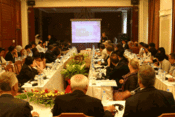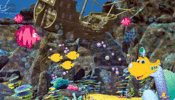UNESCO's Work and Achievements in the Protection of the Underwater Cultural Heritage
The United Nations Educational, Scientific and Cultural Organization (UNESCO) is a specialized agency of the UN. It has 195 Member States and contributes to preserving cultural heritage, such as the world’s underwater cultural heritage.
UNESCO’s work to protect cultural heritage is one of the most visible, universally acknowledged and respected international conservation initiatives ever undertaken. UNESCO’s work has seen a myriad of success stories and concrete conservation achievements.
UNESCO has engaged in fostering the protection of underwater cultural heritage since the 1960s, when a UNESCO mission first mapped the submerged remains of the Pharos lighthouse in Alexandria harbor - one of the Seven Wonders of the Ancient World.
Since then, UNESCO has adopted a major legal treaty to protect submerged remains with the 2001 Convention. Additionally UNESCO has been involved in the training of underwater archaeologists worldwide, engaging in policy work to achieve a better protection of sites, and fighting treasure-hunting and pillaging. It also provides a platform for States to adopt a common approach to heritage protection and endeavored to change the public perception of underwater cultural heritage, to raise awareness and appreciation for what it is – a unique legacy of humanity.
The 2001 Convention
A major achievement in UNESCO’s work to protect submerged sites was the adoption of the UNESCO 2001 Convention on the Protection of the Underwater Cultural Heritage.
The Convention was developed and adopted by the Member States of UNESCO. It sets a common standard for the protection of submerged heritage, with a view towards preventing the looting and destruction of such heritage. Additionally, it allows for the comprehensive protection of underwater cultural heritage wherever it is located, harmonization between the protection of underwater cultural heritage with that of heritage on land and the provision of guidelines for archaeologists on the proper treatment of underwater cultural heritage.
The 2001 Convention on the Protection of the Underwater Cultural Heritage is already binding for 49 States, and more prepare to join.
The Convention expected to shape the discipline of underwater archaeology, as well as the protection of submerged heritage for the future worldwide. The Convention is UNESCO’s main tool to improve the legal and operational protection of underwater cultural heritage.
A Forum for States
UNESCO provides a forum for the adoption of a common approach by all States towards underwater heritage protection through the 2001 Convention’s Meeting of States Parties and its Scientific and Technical Advisory Body.
As Secretariat of the 2001 Convention, UNESCO:
• organizes the Meeting of States Parties to the Convention and its Scientific and Technical Advisory Body
• assists States Parties in the implementation of the decisions made at these meetings
• facilitates information exchange on the Convention and helps States to become State Party
• organizes regional and national meetings to make the Convention and underwater cultural heritage better known and to enable an exchange of experiences
The Scientific and Technical Advisory Body
The Scientific and Technical Advisory Body of the UNESCO 2001 Convention fosters the development of scientific underwater archaeology and site protection.
It developed, for instance, a Code of Ethics for Diving on Submerged Archaeological Sites, which is now applicable to all divers in States Parties and nationals of States Parties. It also made concrete recommendations on how to review national legislation protecting underwater cultural heritage. It recommends, among others, the adoption of a set of clear national rules for the authorization of interventions, the installation of an obligatory cooperation between the various institutions and the adoption of guidelines for the establishment of national inventories.
The Support of UNESCO to States
To foster the adoption of the highest ethical standards in the protection of underwater cultural heritage, UNESCO has organized more than 30 intergovernmental meetings, in all regions of the world, on the Convention and the protection of underwater cultural heritage.
It has also actively assisted States in harmonizing their laws with the Convention and provided a model law for the protection of underwater cultural heritage.
The support provided by UNESCO has greatly contributed to increase the importance of underwater heritage and underwater archaeology to national governments.
Publications on Underwater Heritage
UNESCO has provided a comprehensive underwater archaeology Manual and a 600-page training course book, available in several languages. Both can be accessed freely online through our Resources and Downloads page.
Moreover, UNESCO:
• produces publications to improve the understanding of the Convention on the Protection of the Underwater Cultural Heritage and to make information on it and the field of underwater cultural heritage protection better known and more accessible
• endorses best practices in underwater archaeology by granting patronage to selected national, regional and international programs, projects and activities for safeguarding underwater cultural heritage
• compiled a National Cultural Heritage Law Database that facilitates access to and comparison of national laws protecting underwater heritage
Capacity-Building
In order to achieve the proper protection, preservation and research of underwater cultural heritage, it is necessary to rely on trained professionals that -along with an appropriate legal framework- safeguard the concerned sites.
UNESCO is committed to this cause through diverse capacity-building programmes organized either by its Headquarters or by the more than 50 field offices. It does so in cooperation with reliable implementation partners in almost every region worldwide.
Between 2008 and the present UNESCO has trained more than 400 specialists from more than 80 countries in underwater archaeological research with courses lasting from 2 weeks to 3 months.
UNESCO has also established a university twinning programme for underwater technology in order to improve academic research and training. This programme brings universities from around the world together to teach underwater archaeology.
Outreach & Awareness
Heritage should be enjoyed by all and be cared for by all.
UNESCO hence works to raise public awareness and promote the value and significance of underwater cultural heritage and the importance of protecting it. Its 2001 Convention encourages responsible public access to sites with the belief that Heritage should be enjoyed in situ.
UNESCO publishes information through several forms of media; it informs through its 7-language Website, and provides material such as films, TV shows and information brochures publications on underwater heritage for the public at large.
UNESCO has also organized numerous exhibitions all over the world. Notably, the exhibition in a major aquarium in Bangkok, which included dive-intervention demonstrations by archaeologists, has been visited by some 150.000 visitors.
Moreover, the Director-General recently opened/unveiled a photo exhibition at the Castillo de la Real Fuerza in Havana, Cuba.
Children and Underwater Heritage
UNESCO has established, in co-operation with the cartoon producer Moonscoop, a UNESCO UCH Kids programme on underwater cultural heritage. This consisted of a webpage, twelve TV episodes for children that ran on major channels such as the Disney channel and other child-oriented publications and activities.
Furthermore, UNESCO is working on a digital application for tablets and smartphones, which will reproduce underwater archaeological sites and teach their history to children.
UNESCO also provides children with information on submerged heritage and the need to protect it on its Underwater Cultural Heritage Kids Page.















